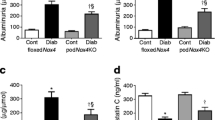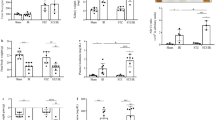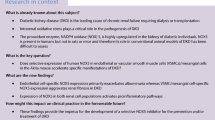Abstract.
Nitric oxide (NO) is a multifunctional mediator that has been implicated in the short-term hemodynamic alterations that occur in acute streptozocin (STZ)-induced diabetes. We investigated the role of NO produced by inducible nitric oxide synthase (iNOS) in chronic STZ diabetic nephropathy. Diabetes was induced in C57BL/6 and iNOS knockout (KO) mice with two intraperitoneal injections of STZ, 100 mg/kg. Animals were maintained without insulin treatment for 40 weeks. There were no significant differences between the strains in blood urea nitrogen (BUN), serum creatinine or glucose concentration, or urinary protein excretion during the entire observation period. Urinary nitrite + nitrate excretion was significantly lower in iNOS KO mice compared to control animals at all time points; in C57 mice, urinary nitrite declined progressively with more prolonged duration of diabetes. Renal hypertrophy (kidney weight/body weight) was noted in both strains of mice. However, histopathological assessment of renal tissue specimens at 16 and 40 weeks demonstrated increased mesangial hypercellularity and expansion as well as more prominent tubulointerstitial fibrosis in iNOS KO versus C57 mice. These changes were accompanied by increased interstitial deposition of type I collagen at 16 and 40 weeks in iNOS KO mice. Glomerular basement membrane staining for type IV collagen was also increased at 40 weeks in diabetic iNOS KO mice. While iNOS protein was undetectable in any of the kidney specimens obtained from either strain, eNOS was present throughout the course of chronic STZ diabetes. Moreover, eNOS expression was significantly increased by approximately 40% at 16 and 40 weeks of observation in iNOS KO versus C57 mice. There was no difference in renal cortical malondialdehyde content between the strains early or late in the disease course. In time control animals, there was no evidence of renal histopathological damage in iNOS KO or C57 mice after 40 weeks. We conclude that iNOS-derived NO modulates glomerulosclerosis and tubulointerstitial fibrosis in chronic STZ nephropathy. This action is probably a result of the direct actions of NO on the synthesis and degradation of extracellular matrix proteins.
Similar content being viewed by others
Author information
Authors and Affiliations
Additional information
Received: 28 February 2001 / Revised: 10 August 2001 / Accepted: 13 August 2001
Rights and permissions
About this article
Cite this article
Trachtman, H., Futterweit, S., Pine, E. et al. Chronic diabetic nephropathy: role of inducible nitric oxide synthase. Pediatr Nephrol 17, 20–29 (2002). https://doi.org/10.1007/s004670200004
Issue Date:
DOI: https://doi.org/10.1007/s004670200004




